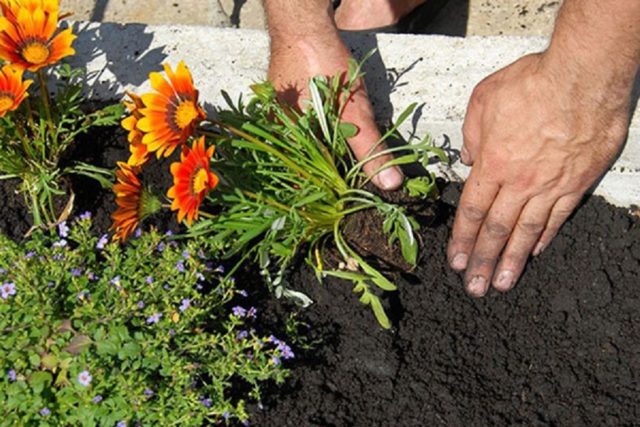Content
The end of the summer season is a very colorful period when lush blooming roses, clematis, peonies are replaced by late, but no less vibrant crops. These include autumn helenium, which reveals its charm just at the time when most of the garden plants are fading.
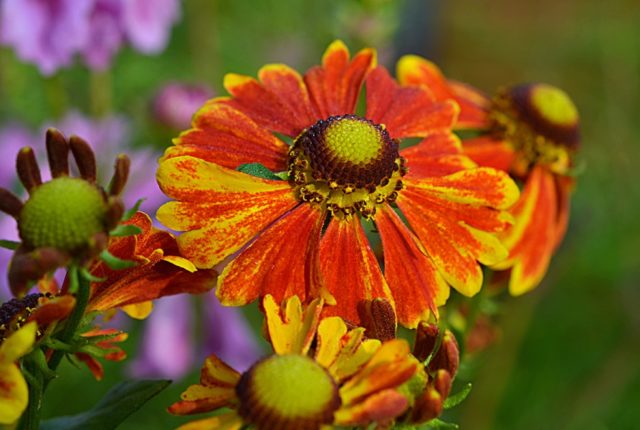
Bright and very colorful gelenium flowers are a real treasure of the autumn garden.
General description of autumn helenium
Helenium autumnale is a perennial herb belonging to the Asteraceae family of the same genus. In natural conditions, this flower can be found along roads and roadsides, as well as in wetlands and meadows. Its homeland is North America, the plant is distributed throughout the world as a horticultural crop. And when the proper conditions are provided, helenium grows rapidly, forming branched, flowering and lush bushes.
Stems are erect, slightly pubescent, powerful. In one bush, their number is from 1 to 7 pieces, they together form a column. Depending on the variety, autumn helenium can grow from 50 cm to 1.5 m in height. The green mass is moderate, alternating along the entire length of the stem. The leaf plates are small, lanceolate, elongated, with serrated or smooth edges, slightly pubescent.
The flowering period is July-October. The very first buds can be seen at the end of June at the tops of the shoots. At this time, single flowers with a protruding rounded basket are formed. Their diameter is approximately 3-5 cm. The color varies from yellow to brown-red. The petals have a scalloped edge. The heart is convex, consisting of numerous small tubular flowers.
From 15 to 20 inflorescences can form on one stem at the same time. Depending on the variety, they have a terry, semi-double or plain surface and are different in shade.
At the end of the flowering of helenium, cylindrical, oblong achenes of a light brown shade, slightly pubescent, appear. They do not exceed 2 mm in length and have a crest of 5-7 scales.
Popular varieties
Today, thanks to the work of breeders, there are a considerable number of different varieties of autumn helenium that can meet the expectations of even the most fastidious gardeners. At the same time, hybrid species have a significant advantage, which consists in a longer flowering period.
Gelenium Fiesta
Gelenium Fiesta (Helenium Fiesta) reaches a height of 1 m and is an upright bush with elongated lanceolate leaves. Flower shoots are underdeveloped, and baskets with a diameter of 5 cm are formed at their ends.
The flowering period is average (August-September), but, despite this, the variety is very popular among gardeners. The Gelenium Fiesta received recognition thanks to the unusual color of the petals, namely the yellow edge on both sides, which turns into orange closer to the middle.In inflorescences, this color looks very bright, resembling a fiery flame on a golden background.
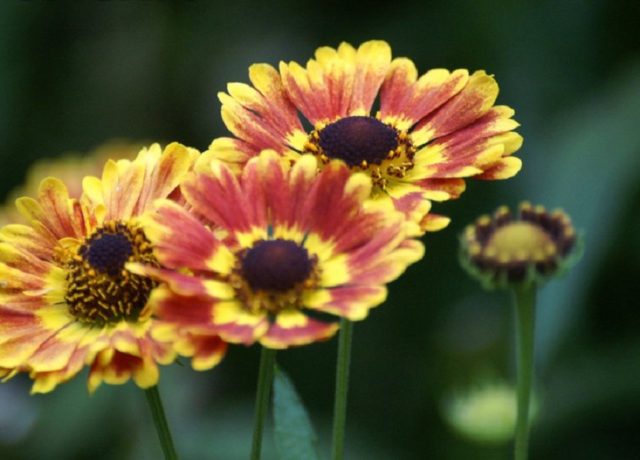
The unusual color of the Fiesta variety helenium allows you to create unique autumn compositions in the garden
Gelenium Chelsea
The recently developed hybrid of Chelsea helenium (Chelsey) is a medium-sized variety (60-80 cm), with an inflorescence circumference of up to 8 cm.The color of the central part has a rich brown-red hue with a golden belt, while the tubular flowers combine 2 tones at once (bright -yellow and raspberry).

The flowering period of Chelsea helenium falls in July-August
Moerham Beauty
Moerheim Beauty is one of the most common varieties of autumn helenium. The bush is tall (90-120 cm), the stems are strong and wind-resistant. Tubular flowers are initially bronze-red after opening, but then they change color to fiery orange. The central convex part is terry, with a burgundy color. Inflorescences are medium in size, up to 6.5 cm in circumference. The plant blooms from early August to mid-October.
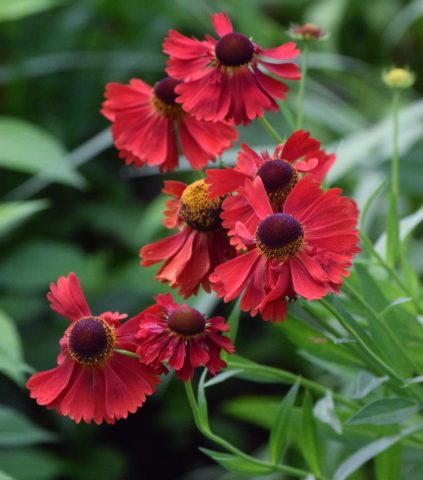
The Moerchem Beauty variety is distinguished by high and rather powerful stems that do not need support.
Ruby Tuesday
Ruby Tuesday (Ruby Tuesday) belongs to one of the low-growing varieties of autumn helenium, which reaches no more than 50 cm. Stems are smooth, without the usual edge for this type of plant.
The flowers are small, only 3 cm in circumference. Their color is burgundy-red, and the embossed core has a yellow-brown color.
Blooms for a relatively long time, starting from the end of the first week of July.
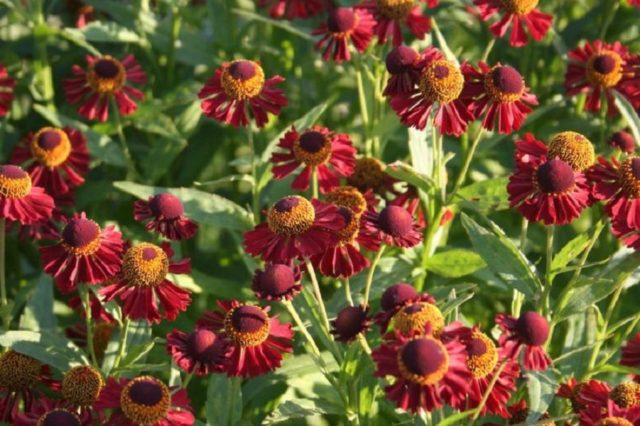
Due to its small size, Ruby Tuesday's autumn helenium is suitable for container cultivation
Double Trouble
Gelenium of the Double Trouble variety is very effective outwardly thanks to its bright yellow flowers. Its bushes grow up to 80 cm in height, the diameter of the inflorescences is approximately 4.5 cm.
The color is lemon, and the convex yellow core with a greenish tint. And for the entire flowering period (from July to the end of September), the color of the inflorescence does not change.
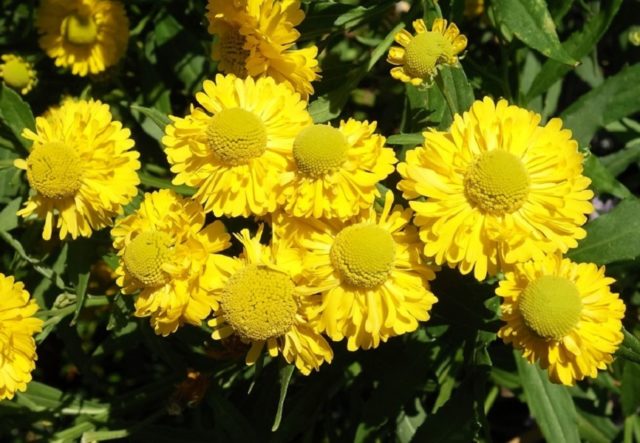
The Double Trouble variety is the only terry variety
Application in landscape design
Autumn Gelenium is popular not only among gardeners, but also among landscape designers, due to its unpretentiousness and later flowering period.
Such a plant looks good both in mono-plantings and in compositions. Tall varieties of autumn helenium can be used as a hedge or for decorating the facades of outbuildings on the site. When used as a tapeworm, helenium will look spectacular against the background of other late flowering plants. In this case, plants such as delphinium, sedum, rudbeckia are suitable.
Medium-sized specimens perfectly complement the cascading flower beds in the background. They can also harmonize well with flowers that are similar in shade: marigolds, heuchera, goldenrod, steep.
A more contrasting combination is often used, namely, autumn helenium is planted together with snow-white asters or bright varieties of phlox.
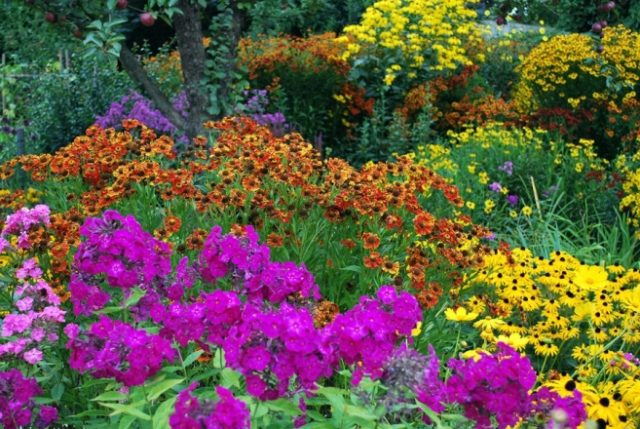
The combination of phlox with helenium creates an even more interesting atmosphere with bright colors
Low-growing varieties are most often used for framing curbs and garden paths.
Breeding features
For reproduction of autumn helenium, 3 methods are used:
- seminal;
- cuttings;
- using sockets.
The seed method involves sowing seeds in open ground or to obtain seedlings. But, as a rule, this method is not only ineffective, since not all planting material can sprout, but also the most time-consuming, because planting of seedlings is required to start at the beginning of spring.
The method of cuttings, in comparison with seed, is considered to be faster. For successful reproduction of autumn helenium, planting material is first selected and harvested.A suitable stalk is cut off from the shoot, then it is placed in a special solution with a root growth stimulator. After the rooted cutting is planted in open ground.
Reproduction of autumn helenium using outlets also refers to the quick methods. This method should be used in the spring, since in the fall there is a possibility that with the arrival of the first frost, the seedling will die.
Growing seedlings of autumn helenium
Despite the fact that the seed method is not the most successful, it is still used to propagate autumn helenium. Basically, this method is more common in the northern regions.
Sowing helenium seeds for seedlings is carried out at the end of February or at the beginning of March. In this case, it is best to choose exactly long containers made of durable plastic or wooden boxes. The substrate should be as nutritious as possible, therefore it is recommended to use ready-made store soil designed for growing flowering plants.
Before laying the substrate, a drainage layer must be provided. To do this, use expanded clay or crushed stone. They also make sure that the soil is moist. Gelenium seeds are placed superficially, without deepening them, but lightly sprinkled with a thin layer of sand. The container is covered with glass or foil and placed in a room with a temperature of approximately + 20 ° C.
If all the initial steps are performed correctly, then the first shoots of helenium will hatch in 4-5 weeks. And when 2 full-fledged leaves appear, the seedlings are transplanted into separate peat pots, while diving them.
Planting and caring for autumn helenium in the ground
Having received good and healthy seedlings of autumn helenium, you can start transplanting it into open ground. Also, sowing seeds directly to a permanent place is not excluded. It is only important to comply with the planting dates and all care requirements in both cases.
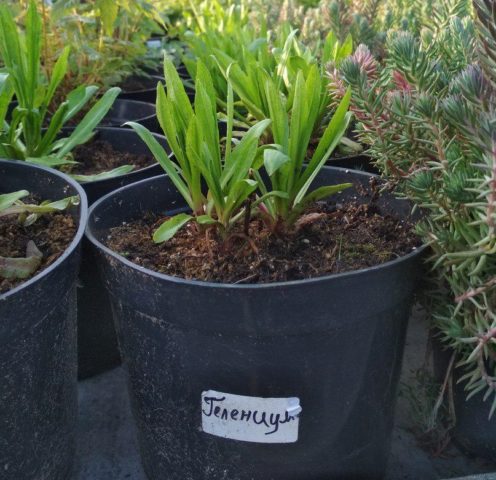
Seeds of autumn helenium have a low percentage of germination, so it is worth using the seedling method of growing
Recommended timing
Planting of seedlings of autumn helenium is carried out from late May to early June, depending on climatic conditions. In this case, it is important that the earth is well warmed up.
If the seeds are sown directly into open ground, then this can be done in late autumn in the second half of October and early November. And also spring sowing is not excluded - in April-May.
Site selection and soil preparation
There are no special requirements for the choice of a place for planting autumn helenium, but still it is worth considering the following:
- good illumination of the site, partial shade is acceptable;
- protection from through winds.
The soil, on the other hand, should be neutral or slightly acidic, not depleted and well permeable to air.
Before planting, the site must be dug up, removing all weeds. Then organic fertilizers (compost) are applied. If the soil is acidic, then lime should be added to it.
Landing algorithm
The algorithm for sowing seeds and planting seedlings of autumn helenium in open ground consists in the following actions:
- In the prepared soil, shallow grooves (1-2 cm deep) are first made at a distance of 25 cm from each other.
- Gelenium seeds are evenly distributed into the grooves and lightly sprinkled with a layer of sand.
- Water the planted area abundantly.
- As soon as the water is completely absorbed into the soil, mulching is performed with a thin layer of peat or humus.
- The bed is covered with a film, which is removed daily for ventilation and removal of condensation.
When planting seedlings, they are seated on the garden bed taking into account the distance from each other 15-25 cm. Ideally, 1 sq. m there should be no more than 4 helenium bushes.
Watering and feeding schedule
Autumn Gelenium requires frequent and abundant watering, as it can hardly tolerate drought.Irrigation is especially necessary in the summer season, despite the fact that the plant blooms closer to autumn.
It should also be borne in mind that the stagnation of moisture in the root zone is detrimental to the plant, therefore it is advisable to provide for the presence of drainage during planting.
The autumn helenium also needs feeding, as well as watering. It is fertilized at least 3 times per season:
- spring feeding, it is produced in early May by watering the plant with a nitrogen-containing fertilizer (for example, a solution of urea with water in a ratio of 20 g per 10 l);
- the second feeding, it is carried out at the stage of budding with the use of mineral complex fertilizers (such preparations as Agricola-7 or Agricola-Fantasy are suitable) they are bred with 10 liters of water and 1 liter of cow dung;
- autumn feeding, it is performed at the end of October to strengthen the plant for the winter period (in this case, a solution of potassium sulfate and superphosphate, 20 g each with 10 liters of water is suitable).
Loosening, weeding, mulching
In order to avoid the accumulation of water, after each watering of the helenium, it is imperative that the soil is loosened. This procedure is also necessary for the plant's root system to be more oxygenated.
At the time of loosening, it is worth weeding at the same time so that weeds do not drown out the growth of autumn helenium.
To reduce the evaporation of moisture from the soil and reduce the number of weeds, you can mulch the root zone of the plant. Dry peat or sawdust should be used as mulch.
Pruning and maintenance during flowering
Autumn Gelenium needs regular pruning. This will preserve its beautiful shape and dense greenery. Pruning is also necessary due to the fact that at the end of flowering, the stems begin to die off and dry out, so they need to be removed. Do this by leaving at least 15 cm on the surface.
Diseases and pests
Autumn helenium is a plant resistant to many diseases and pests, but still the bush can be affected by such an ailment as a chrysanthemum nematode. Drying and falling leaves serve as signs of its appearance.
To get rid of the pest, the plant is first subjected to a thorough examination, then all affected parts are removed and watered with a weak sulfuric or lime solution.
As for diseases, the most dangerous for autumn helenium are rot and fungus, which can occur due to waterlogging of the soil.
Conclusion
Autumn Gelenium is a unique garden plant that, with proper planting and proper care, will delight you with beautiful flowering throughout the fall. It looks great in compositions and in single flower beds, and also plays an important role in floristry, allowing you to create bright bouquets.
